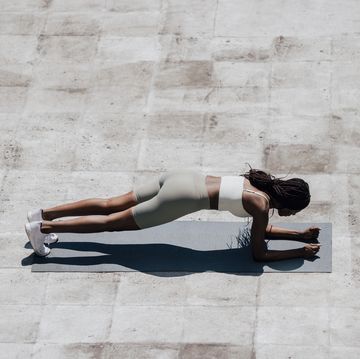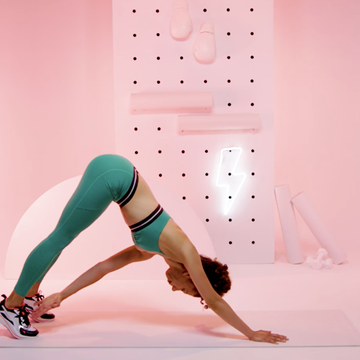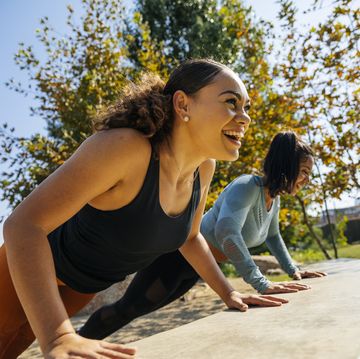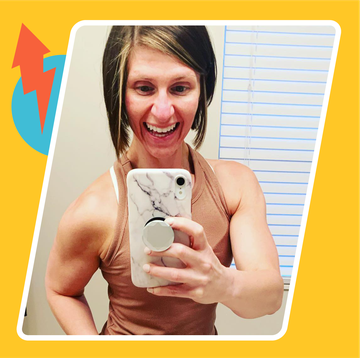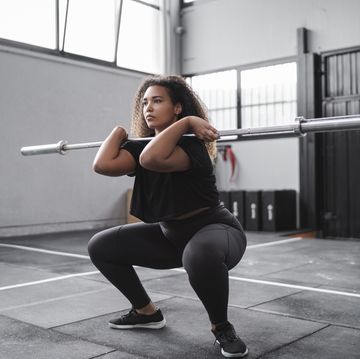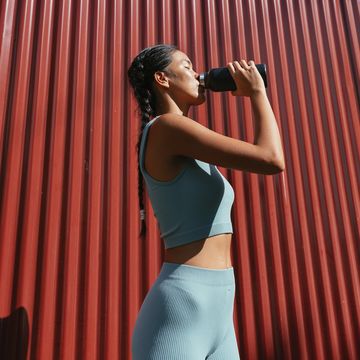If the thought of two-a-day workouts makes you sweat before they even start, you’re not alone. After all, upping training to this level is typically associated with pro athletes or high school pre-season sports.
But before you reject the idea of training twice a day, hear us out because there are actually tons of benefits. Think: hitting your fitness goals faster, building muscle quicker, and reducing health risks associated with a sedentary lifestyle. Now of course, this all depends on your current fitness ability, stress levels, diet, sleep and what those workouts actually look like, says personal trainer Michelle Marques, CPT.
Meet the experts: Albert Matheny, CSCS, is a certified strength and conditioning specialist and cofounder of SoHo Strength Lab. Jim Pivarnik, PhD, is a professor of kinesiology at Michigan State University. Maya Evans, CPT, is a certified personal trainer and House of Athlete Plus coach.
“The key to a two-a-day workout routine is creating a practical and adaptable plan that works with your current fitness level, lifestyle, and goals,” says Maya Evans, CPT, a certified personal trainer and House of Athlete Plus coach.
Think about it: Say you're cross-training and trying to make sure you're getting enough cardio, weightlifting, speed work, and improving your mobility. If you don't want to work out every day it can feel near impossible to fit all these different types of exercise into your fitness routine consistently enough to see real results.
Feel physically and mentally strong enough to tackle more than one workout per day, but want to know if you should? Here’s everything you need to know about two-a-day workouts—including the potential benefits, risks, and best practices for making them work for YOU, according to trainers.
Are two-a-day workouts safe?
Long story short: Two-a-days can be A-okay, “as long as you’re following a structured program and not simply exercising without direction or guidance," says Doug Sklar, CPT, founder of New York City-based fitness studio PhilanthroFIT.
However, if you don't give yourself enough time to recover between your workouts, you might wind up injured or burnt out, says Albert Matheny, CSCS, cofounder of SoHo Strength Lab. Successfully working out twice a day in a healthy way requires on-point sleep, nutrition, and hydration.
Benefits Of Two-A-Day Workouts
As long as your two-a-day workouts are programmed properly (more on that in a jif), you can reap some legit benefits like...
1. Increase your lean muscle mass percentage faster. Any time you work your muscles or revv your heart rate, something called excess post-exercise oxygen consumption (EPOC) sets in. “EPOC is the energy used to support post-workout recovery and it helps you burn more calories even after you leave the gym,” explains Rebecca Kordecki, CPT. As long as your nutrition is level 100, tapping into EPOC twice per day can help you lose fat and gain muscle at the same time...but quicker.
2. Double up on the endorphins. Hey, that runner’s high and post-PR bliss are no joke. “Hit the gym twice and you’ll double your hit of mood-boosting endorphins, which can be great for folks who struggle with low mood,” says Kordecki. Endorphins, or the body’s feel-good hormones, are released when you exercise, and help boost your mood, decrease feelings of stress, and increase your positive sense of well-being, adds Evans. “Working out twice a day can increase the benefits from exercise-induced endorphins, and exercise can also improve your ability to focus throughout the day and lead to better sleep at night.”
3. Improve your overall strength and endurance. “With two workouts a day, there is an increase in training volume which can activate greater improvements in muscle strength and size,” says Evans. As a result, doubling up on your workouts will trigger accelerated muscle growth to help you reach your goals faster. Plus, the extra workout time also helps boost stamina and endurance which will reduce fatigue and allow you to perform activities at a higher level, adds Evans.
4. Decrease your sedentary time. Thanks to #WFH, it’s way too easy to sit around all day (guilty!). After all, statistics show Americans sit for more than 8 hours a day, says Evans. “Getting up and moving your body with not only one workout but two workouts a day will decrease your sedentary time, or time spent sitting, and can therefore decrease the risk of health problems and diseases related to sitting too much,” she explains. In fact, a sedentary lifestyle can cause adverse health conditions like cardiovascular disease, metabolic syndrome, cancer, and muscular diseases like osteoporosis, a 2020 study found.
In a nutshell, working out more can help you get fitter, faster—if you do it right, says Jim Pivarnik, PhD, a professor of kinesiology at Michigan State University. This can be beneficial in a few different situations, like if you’re trying to build up your endurance for a running or swimming race but also want to work on your speed, he says. Same goes if you’re training for a triathlon and have a bunch of different things you need to focus on.
Potential Downsides Of Two-A-Day Workouts
Working out twice a day can mean doubling up on injury risk and burnout if you're not careful. It all comes down to two factors: your form and your recovery.
The result of too much exercise coupled with insufficient recovery, overtraining is marked by stalled performance—or worse: regression, says Marques. “If our bodies don’t have time to repair themselves between workouts, they continually get broken down and never reach the point where you're reaping any benefit from the workouts you’re doing,” she explains.
Other symptoms of overtraining include exercise burnout (a.k.a. a *complete* lack of motivation to get sweaty), wonky sleep, and mood swings. If you notice any of the telltale signs of overtraining, you should dial it back.
How To Create An Effective Two-A-Day Workout Plan
Reaping the benefits of two-a-day workouts without going overboard may seem like a bit of a tightrope walk—but you can totally pull it off with help from pro trainers.
1. Vary the intensity. “Two super-intense workouts a day are not the way to go,” says Marques. Ditto goes for doing the same workout twice. Mixing up your intensity is a must. Ideally, “the higher intensity workout will be in the morning, and the lower-intensity will occur later on,” says Kordecki. So, if you go hard at spin class in the a.m., maybe opt for an active recovery workout in the evening.
2. Split up cardio and strength. You’ll also want to prioritize the type of training that best supports your goals in the morning, suggests Kordecki. Prepping for a lifting competition? Do your workout of the day (or WOD) in the morning and take a walk or yoga class in the evening. Preparing for a 5k? Run first, strength second. (Here's even more expert intel on whether to do strength or cardio first.)
3. Don’t double up every day. It’s important to ease into how many double sessions you do, says Matheny. If your goal is to work up to two or three two-a-days a week, start out with one and ramp up over the course of a few weeks. None of the pros recommend doing two-a-day workouts every day—or even every other, unless your fitness level is closer to a pro than a recreational exerciser.
4. Keep a fitness log. Tracking your performance may seem like a chore, but it can help you monitor whether you’re actually seeing a benefit from working out twice a day. “If you’re continuing to get positive results, that means you’re doing everything right,” Matheny says. If progress has plateaued, though, odds are you’re veering into overtraining territory and need to ease off the gas.
5. Tap the pros. If you’re going to jump into two-a-day workout territory, find a trainer who can give you the guidance you need to stay safe and learn with confidence, suggests Los Angeles-based celebrity trainer, Kathy Freeman, co-creator of the 30 Day Transformation Team Program. Working with a pro guarantees your workouts will be strategic and personalized to you.
6. Play the long game. You’re forgiven for wanting results FAST, but the key to successful two-a-days is to keep your eyes on the horizon. “Working out isn’t just about your short-term goals,” Marques says. If you’re not strategic and get injured, that will ultimately mess with your fitness goals much more than two-a-days can help them.
7. Schedule complete rest days. “Rest is as crucial to transforming your body and reaching your fitness goals as your workouts are,” says Freeman. Schedule in at least two full rest days per week to make sure you don’t push yourself into burnout zone.
8. Separate your sessions. “Ideally, you would have time to fuel your body with protein and carbohydrates for energy in addition to rehydrating with water in between workouts,” says Evans. It’s also best to do one workout in the morning then another in the evening instead of back-to-back sessions with no rest in between, she adds.
9. Above all, listen to your body. “If you feel like crap, that’s your body telling you what you’re doing isn’t quite working,” says Marques. Say it with us now: rest!
Bottom line: Working out twice a day may be helpful for reaching your fitness goals faster, but you should really do it under the supervision of a trainer who can make sure your efforts are targeted, and you're not overtaxing your body.

Gabrielle Kassel (she/her) is a sex and fitness journalist committed to helping people feel the best they can in their bodies. In addition to Men’s Health, her work has appeared in publications such as Shape, Cosmopolitan, Well+Good, Health, Self, Women’s Health, Greatist, and more! In her free time, Gabrielle can be found coaching CrossFit, reviewing pleasure products, hiking with her border collie, or recording episodes of the podcast she co-hosts called Bad In Bed. Follow her on Instagram @Gabriellekassel.
Andi Breitowich is a Chicago-based writer and graduate student at Northwestern Medill. She’s a mass consumer of social media and cares about women’s rights, holistic wellness, and non-stigmatizing reproductive care. As a former collegiate pole vaulter, she has a love for all things fitness and is currently obsessed with Peloton Tread workouts and hot yoga.

